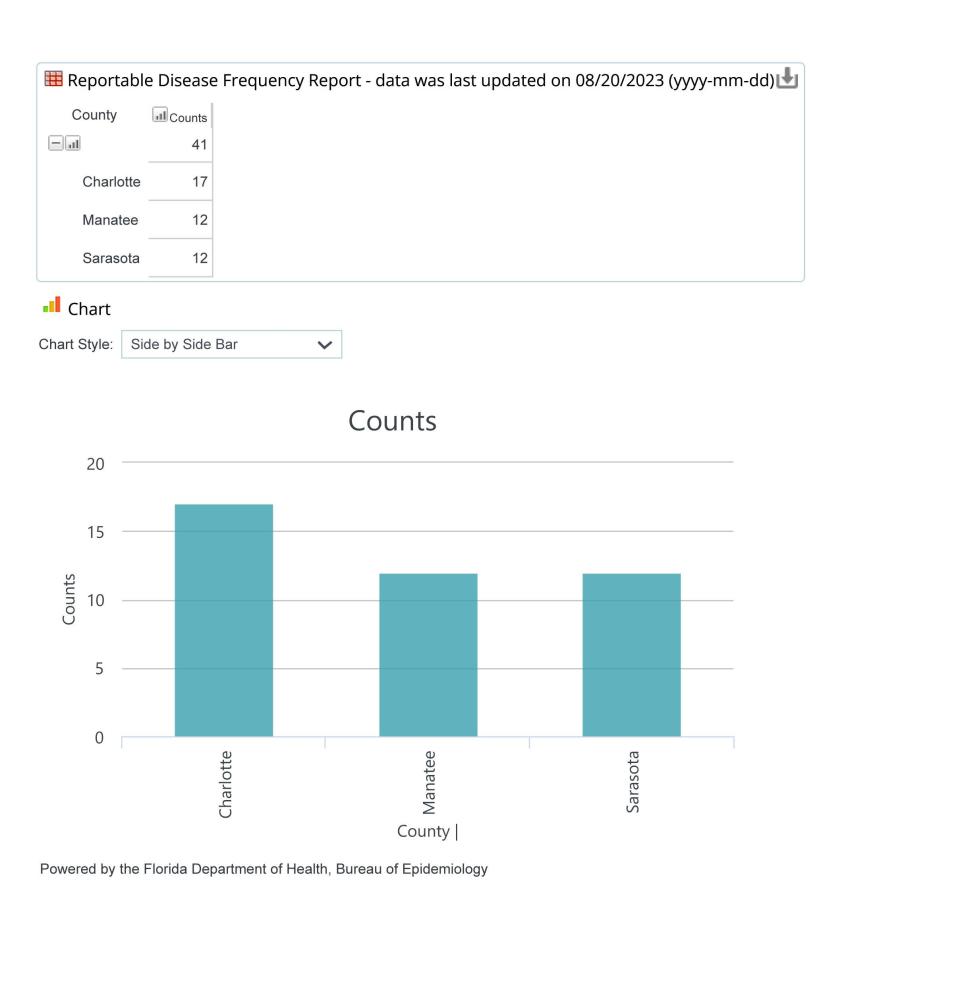Two people in Sarasota County have contracted 'flesh-eating bacteria' since May; one died

Recent news reports regarding deaths attributed to a rare flesh-eating bacteria noted that one of the five deaths since Jan. 1 that occurred in Florida was in Sarasota County.
Florida Department of Health records indicated that there have been only two incidents in Sarasota of people infected with that bacteria, Vibrio vulnificus – one in May and one in June.
A state Department of Health spokesman cited HIPA-related privacy concerns and declined to say which of the two cases resulted in the fatality. The agency also did not list the causes of the Florida cases.
“It is very easy to cure – its’ an antibiotic – but the key is catching it early,” said Jae Williams, the press secretary for the Florida Department of Health in Tallahassee.
Vibrio vulnificus bacteria occurs naturally in coastal waters and is more prevalent in summer months. It can be found in raw or undercooked seafood, saltwater, and brackish water.
If an exposure – either by ingesting it through seawater or shellfish, or through an open wound – goes untreated, that could cause death.
“It’s rare, it’s incredibly rare – it's a thing and it’s something that as Floridians we have to work with,” said Williams, who urged anyone who experiences high fever, bad chills and aches after eating raw shellfish or swimming in warm brackish water, should have their physician test them to rule out Vibrio – typically referred to as Vibriosis.
Technically, it's inaccurate to call Vibrio vulnifus the “flesh-eating bacteria” because it kills, but does not eat tissue. The bacteria cannot penetrate intact skin, but must enter through an existing break in the skin. If the bacteria enters the body through a cut or wound it can cause necrotizing fasciitis, in which the flesh around the infection site dies. Vulnificus means "to wound" in Latin.
Some Vibrio vulnificus infections can lead to life-threatening wound infections in which the flesh around an open wound dies, according to the Centers for Disease Control and Prevention. Many who are infected may need intensive care or limb amputations; about 1 in 5 who get the infection die, sometimes within a day or two of becoming ill, the CDC says.
About 80,000 people get vibrio infections each year and about 100 people die from the infection annually in the U.S, the CDC says.
Related: Rare flesh-eating bacteria kills 5 in Florida, 3 in New York, Connecticut
A Hurricane Ian-prompted spike
Since Jan. 1 there have been 26 confirmed cases of Vibriosis in Florida, resulting in five deaths – including the one in Sarasota County, as recorded at https://www.flhealthcharts.gov. There were also two deaths in Hillsborough County and one each in Pasco and Polk County.
There has been one confirmed case in Charlotte County this year and none in Manatee County.
Over the past decade – from Jan. 1, 2013 through Aug. 20, 2023 – there have been a total of 41 confirmed Vibriosis cases in Charlotte (17), Manatee (12) and Sarasota (12) counties according to the Florida Department of Health's database of reportable disease frequencies.

A separate Health Department database that lists states and deaths statewide from 2008 through 2023 lists 2022 as an anomaly attributed to Hurricane Ian.
Statewide there were 74 confirmed cases and 17 deaths including 28 cases and eight deaths in Lee County.
“Specifically Hurricane Ian, that was the perfect cocktail for Vibrio to develop,” Williams said. “That’s why there is that huge spike and also a huge spike in deaths.”
Double digit deaths were recorded in eight of those 16 years. In 2019, only two people died with 27 cases confirmed.
One of those 2019 deaths occurred that July, when an Ellenton woman contracted necrotizing fasciitis after she cut herself on a rock while walking in the Gulf along Coquina Beach.
In May of that year, a woman contracted cellulitis after falling while walking in the Gulf on Siesta Beach but recovered.
In 2014, the death of a Sarasota man was linked to Vibriosis – prompting the Florida Department of Health in Sarasota County to issue a marine bacteria warning.
No such warning has been issued this year.
Flesh-eating bacteria is 'always in the water' and heading north
The bacteria has led to other recent deaths in the Northeast, where New York Gov. Kathy Hochul announced it was detected in a person who died in Long Island.
In Connecticut, three people, aged between 60 and 80 years old, were infected with the bacteria in July, the state's Department of Public Health said. Two of those patients have since died.
Because of climate change and warming ocean waters, Vibrio vulnificus is migrating north, studies have found. "The warmer water is, the more bacteria can reproduce faster," said researcher Gabby Barbarite at Florida Atlantic University's Harbor Branch Oceanographic Institute in Fort Pierce, Florida.
Infections have increased eight-fold between 1988 and 2018 in the U.S., as climate change has warmed the coastal waters where the bacteria live, according to research published in March in the journal Nature Portfolio. The bacteria and infections are spreading northward up the East Coast at a rate of about 30 miles a year, researchers said.
"Cases used to be concentrated almost exclusively in the Gulf of Mexico in the southern United States," Dr. William Schaffner, an infectious disease expert at Vanderbilt University, told USA TODAY earlier this year.
Vibrio vulnificus is "actually always in water," Manisha Juthani, the commissioner of the Connecticut Department of Public Health, said during a news conference Monday.
"What happens in the summertime is that bacteria like this tend to overgrow, and if you have an open wound, you should never be getting into water because there are any number of bacteria that are in the water," she said.
How can I prevent getting infected with Vibrio vulnificus?
According to the CDC, you can reduce your chance of getting infected with the bacteria by following these tips:
If you have a wound (including from a recent surgery, piercing, or tattoo), stay out of saltwater or brackish water, if possible. This includes wading at the beach.
Cover your wound with a waterproof bandage if it could come into contact with saltwater, brackish water, or raw or undercooked seafood and its juices. This contact can happen during everyday activities, such as swimming, fishing or walking on the beach. It could also happen when a hurricane or storm surge causes flooding.
Wash wounds and cuts thoroughly with soap and water if they come into contact with saltwater, brackish water, raw seafood or its juices.
Avoid eating raw or undercooked seafood, particularly oysters. You also can get an infection if an open wound comes into contact with raw or undercooked seafood or its juices.
What are signs and symptoms of a Vibrio vulnificus infection?
Some common signs and symptoms of infection can include:
Watery diarrhea, often accompanied by stomach cramping, nausea, vomiting, and fever.
For bloodstream infection: fever, chills, dangerously low blood pressure, and blistering skin lesions.
For wound infection, which may spread to the rest of the body: fever, redness, pain, swelling, warmth, discoloration, and discharge (leaking fluids).
This report includes reporting from Gabe Hauari, Katie Delk and Mike Snider of the USA TODAY NETWORK.
Earlier: Lyons: 'Flesh-eating' bacteria's real danger is overreaction
This article originally appeared on Sarasota Herald-Tribune: Sarasota County death linked to Vibriosis is one of 5 in state so far

